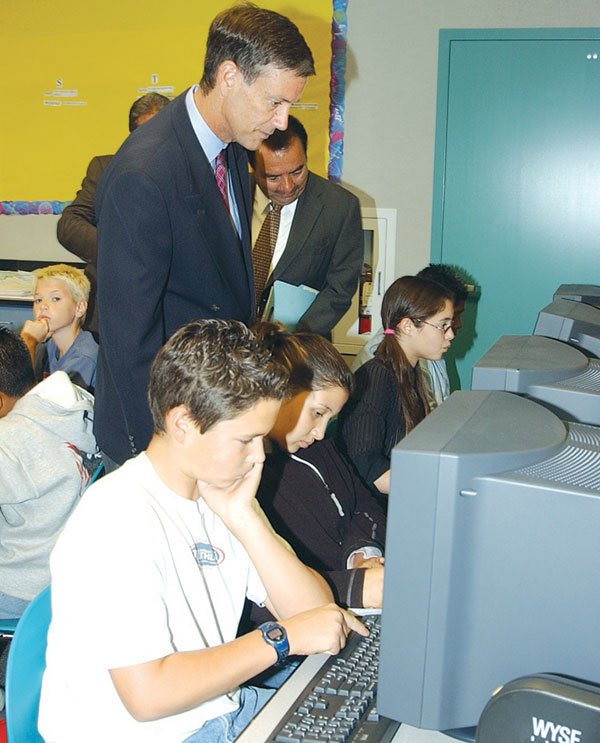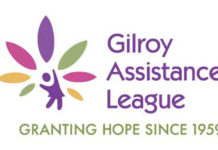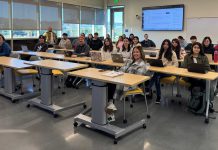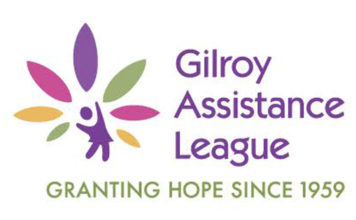Gilroy
– Gilroy Unified is a model for other school districts wanting
to integrate technology into the classroom, State Superintendent of
Public Instruction Jack O’Connell said Tuesday.
In a visit to Ascencion Solorsano Middle School
– and the first to Gilroy by a state superintendent – O’Connell
got a first-hand look at this city’s flagship school both in terms
of facilities and technology.
By Lori Stuenkel
Gilroy – Gilroy Unified is a model for other school districts wanting to integrate technology into the classroom, State Superintendent of Public Instruction Jack O’Connell said Tuesday.
In a visit to Ascencion Solorsano Middle School – and the first to Gilroy by a state superintendent – O’Connell got a first-hand look at this city’s flagship school both in terms of facilities and technology.
The school’s students already are benefiting from a highly competitive technology grant the district received in May, to support its middle school math program and improve falling test scores.
“You have done an outstanding job here, this really is a model program,” O’Connell said.
O’Connell said he was pleased when the technology grant came through for GUSD this spring. The district will receive $350,000 this year to purchase equipment for middle school math classes, but most of the funds will be dedicated to staff development in math and in using technology to teach math.
“We do recognize the importance of making sure we that do utilize technology, especially in the area of math, as math has become more rigorous, more challenging,” O’Connell said.
O’Connell and State Assemblyman Simon Salinas, D-Salinas, toured Solorsano’s media lab and observed the school’s math-and-technology union in action.
In math teacher Val Kelly’s pre-algebra class, four students sat at computers at the front of the room while the rest of the class reviewed for a test. Each day, groups of four students will rotate to the computers for about 10 minutes to use a math tutorial program. The skills adjust to each student’s level and the program corrects them when they make mistakes.
“It’s kind of a personal tutor that walks them through the concepts,” Kelly said. “The program we’re using right now has a really nice description of the material.”
The students usually use the tutorial during class warm-ups or less intrusive times, she said, and since computers are “what students do,” she’s seeing kids more engaged after only a week.
Solorsano may have four computers in each math class, but the district’s other two middle schools – Brownell Academy and South Valley – do not, said Rob van Herk, GUSD’s Information Technology manager. Those will be purchased with the grant funds.
GUSD’s 22 middle school math teachers will be trained to incorporate technology into lessons. For example, they will have the ability to access instructional math Web sites and display them on a television screen to the entire classroom.
All the teachers already have personal Web sites, e-mail addresses and voicemail, van Herk said, something that makes this district stand out.
O’Connell agreed, citing that as a reason he hopes other districts will look to this one when planning how best to incorporate technology.
“Not every school or each teacher has his or her own Web site,” O’Connell said. “All of your math instructors here have their own Web page; they have e-mail; they have voicemail. It’s a great connection to parents that’s very, very positive, because parents are still our most important teachers, and parents are our first teachers.”
GUSD Superintendent Edwin Diaz said Solorsano is an example of what should be implemented in every classroom at every school in the district.
“It doesn’t mean that we’re there yet, otherwise we wouldn’t be struggling with our test scores like we are,” he said. “And talking with Superintendent O’Connell, statewide, 8-to-11th grade math scores are an issue for everybody, so what you’re seeing here today may be characterized as a best practice, and if it’s implemented well, something we can disseminate throughout the rest of the district.”
Student achievement in Gilroy Unified will improve once again, O’Connell said, because the district is aligning instruction to the state’s “world-class” content standards.
“There’s no shortcut to success, it takes hard work,” he said. “Students will be successful because students will be able to think analytically, they will be able to think creatively they will be able to think intelligently – we just don’t want robots taking tests.”
For the past year, O’Connell has urged more of a focus on high school reform, and Tuesday morning he painted a picture of that need that is familiar in Gilroy Unified.
“High schools have been, for various reasons, ignored,” he said. “Our focus has been on the elementary grade levels: On class-size reduction, the alignment of our instructional materials, … or our professional development for our elementary schools. When you look at our test scores, and you extrapolate the data, high school test scores have been relatively flat, unlike our elementary schools, which for the first five years have been going in the same upward direction.”
Middle schools, he said, should provide the foundation for high school success.
In the second year of the technology grant next year, GUSD will receive up to $177,000, van Herk said. There is a possibility a small amount of funding will be available the following year.















